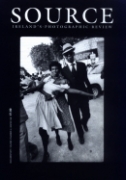The Edge of Europe
Book Review by E. Michael Desilets
Issue 10 Winter 1997
View Contents ▸
Published by: An Roinn Ealaion, Cultur agus Gaeltacha / Gallery of Photography Dublin
ISBN: 0952674122
Price: £21.95
Photographs seldom speak for themselves. This seems particularly true of the work of Anthony Haughey in The Edge of Europe, published to coincide with an exhibition at The Gallery of Photography, Dublin. Though fairly evenly divided between the U.S. and Ireland, from the Bronx to Newtownmountkennedy, this collection of 30 photographs is informed primarily by the depopulation of the Blasket Islands and the emigration of most of the inhabitants to Massachusetts. In the preface by Pat Cooke, a brief memoir by ex-islander Paddy Kearney, the main text by Irish Times columnist Fintan O'Toole and an afterword by Minister for Arts, Culture and the Gaeltacht Michael D. Higgins, we are provided with much guidance (in both Irish and English) as to how to 'read' Haughey's photographs.
In a somewhat fresh approach to reiterating the oft-told tale of the never-ending drift of the Irish to America, O'Toole even draws a parallel between the final abandonment of the Blasket Islands in 1953 to the 1890 murder of Sioux Chief Sitting Bull, who wore around his neck a papal medal taken from an Irishman massacred at Little Bighorn in 1876. Famine Eviction Scene, 'Model World', Newtownmountkennedy, Ireland
Famine Eviction Scene, 'Model World', Newtownmountkennedy, Ireland
This, O'Toole notes, "is a strange, almost absurd collision of cultures, in which Ireland provides the link between Europe and America, between a Pope and a warrior chieftain. But that is the kind of history to which Ireland belongs, one in which the Irish are both a lost civilisation and the destroyers of other tribes, both close enough to the Indians for the Choctaws to have sent aid to the victims of the Irish famine in the 1840's, and far enough from them for it to make sense that it was an Irishman - General Phil Sheridan - who should remark that the only good Indians he ever saw were dead'. 'In one sense', he goes on, 'the Blasket Islanders were dead Indians".
No doubt the Irish have contributed greatly to America's ethnic diversity and racial division. Paddy Kearney, who emigrated to Springfield, Massachusetts, offers a slightly different perspective: "Hear them Puerto Ricans yap yap yap... I don't understand what the hell they're talking about. They can't speak English, they have a hard time communicating. I guess I was in the same boat when I first left the Blasket... I couldn't speak good English, but the Puerto Ricans don't even try, they just stick together and speak their own language". Approaching Ellis Island, New York
Approaching Ellis Island, New York
All very compelling. But what of the photographs? Paddy Kearney himself is featured a number of times - once wearing a powder blue tuxedo, posing under fluorescent lights in a corridor at the State Municipal Hospital in Springfield. Surely a strange place to be seen in formal attire. Yet Springfield itself must have seemed a stranger place when he first arrived there from the edge of Europe.
As Haughey's photographs - the overwhelming majority in colour - take us back and forward across the Atlantic, we notice some obvious parallels, such as pictures of the Sacred Heart on kitchen walls in Kearney family, Springfield, MA, USA and Nell's kitchen, Coimin, County Kerry; and the green, shamrock-festooned nylon jackets on middle-aged men in American Tourists, County Kerry and Irish American, Boston, MA. The most common element, not surprisingly, is water - featured in nearly half the photographs. We see it in Great Blasket Island. Abandoned 1953, East from Rockport, MA, USA, West from Bloody Foreland, County Donegal, Ireland, Gleann Mor, Dunqiun, County Kerry. And so on.
There is much that is sad and drab in this collection. Most of Haughey's human subjects seem decidedly glum. Still, the most striking images in the book are his people: a bearded man, camera on his neck, gripping his American flag umbrella in Approaching Ellis Island, New York; the sad eyed children holding balloons in St. Patrick's Day 1995, Boston, MA, the woman in black wearing a green shamrock pin in Mary, John Boyle O'Reilly Club, Springfield, MA. My favourite is Niamh, Dorchester, Boston, MA, a portrait of a chunky, bespeckled young woman in a red sweatshirt, with a matching gut-level bloodstain on her white butcher's apron. Her pudgy hands at her sides, she stands a bit off-centre in her photographic square, the top of her head cropped off. I can't help but wonder what she might have to say on the subject of the Irish Diaspora. Belmullet, County Mayo
Belmullet, County Mayo
Now living in Dublin, Anthony Haughey was born in Keady, Northern Ireland, and his work appears in the collections of a number of venerable institutions, including the National Museum of Film, Photography and TelevisionThe Victoria and Albert Museum. In the Summer 1996 issue of Source, Christian Caujolle rhapsodised Haughey's "control of framing, daring, and mastery of shade-based composition really makes one yearn for a personal exhibition". Maybe The Edge of Europe isn't personal enough. Pat Cooke notes in his preface that Haughey's parents left Ireland in the 1960's to find work in Liverpool. So his attraction to the subjects of emigration and assimilation is hardly surprising. Overall however The Edge of Europe seems much more of an exhibit catalogue than a book of photographs that stands up on its own; and the written material, especially Fintan O'Toole's essay, provides crucial context for an appreciation of the collection's intent. To Haughey's great credit, nonetheless, his book makes the 'reader' wish he had seen the exhibit itself.
Other articles mentioning Anthony Haughey:
Other articles on photography from the 'Documentary' category ▸





